Canning 101: Home Canned Tomatoes
The following is a guest post from Marisa of Food in Jars. Welcome, Marisa!
Canned tomatoes are a pantry staple. However for most of us, our tomatoes come in cans from the grocery store. For a moment though, imagine what it would be like to have a pantry lined with sparkling glass jars, filled with home canned tomatoes.
It’s far easier than you might think!
What you’ll need for four quarts of tomatoes:
- A large stockpot (for processing the jars)
- A small, round rack (to keep the jars off the bottom of the pot)
- A smaller pot (for blanching the tomatoes)
- A tiny saucepan for simmering lids
- A kettle for boiling water
- 4 clean quart jars, new lids and rings
- A paring knife
- Jarred lemon juice
- A tablespoon measure
- 25 Roma tomatoes
- Boiling water
How to can tomatoes:
1. Place the rack in the bottom of your stockpot. Make sure to choose a pot that will allow the jars to be submerged with at least one inch of water above them and some room still at the top of the pot to allow for boiling.
2. Fill the pot with water and begin to bring to a boil.
3. Fill your smaller blanching pot with water and bring to a boil.
4. Fill the kettle with water and bring to a boil (yes, there’s lots of water boiling in canning).
5. Place lids in the smallest pot and bring to a very low simmer.
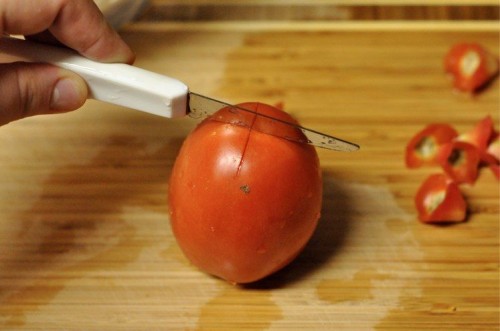
6. While waiting for the blanching water to boil, remove the cores from the tomatoes and carve a small cross into bottoms of the tomatoes, to make them easier to peel post blanching.
7. Once the smaller pot of water has come a boil, blanch the tomatoes in batches of 3 or 4 (keep the batches small so that you don’t drop the water temperature too drastically) for 1-2 minutes. Use a slotted spoon to remove the tomatoes from the blanching water.
8. When tomatoes are cool enough to handle, peel them. You should be able to do this with your hands, but keep that paring knife close for the troublesome spots.
9. Once you have 6 peeled tomatoes, you can fill a jar. If you’re using regular mouthed jars, keep a wooden spoon around, to help you pack the tomatoes into the jars. You should be able to get 5-6 tomatoes into each jar without too much squishing. We’re making whole tomatoes in water here, so do your best not to smash them too much.
10. Keep peeling and filling jars, until you have four filled jars lined up on your countertop.
11. Add two tablespoons of lemon juice to each jar.
12. Top each jar off with the boiling water from the kettle, leaving ½ inch of headspace in each jar.
13. Using the end of your wooden spoon, remove any air bubbles from inside the jars. Add a bit more water if necessary.
14. Using a clean kitchen towel or a bit of paper towel, wipe down the rims of the jars.
15. Place lids on the jars and apply the rings to the jars (don’t tighten those rings too much).
16. Using jar lifters or tongs (take care when using tongs, it’s easy to give yourself a boiling water burn with them), gently lower the jars into the canning pot. You may need to remove some water, a 2-cup pyrex measuring cup does this task well.
17. Once all the jars are in the processing pot, put a lid on it and bring it back up to a boil. Adjust the burner temperature to keep the pot boiling gently. Process for 45 minutes.
18. When the time is up, remove the jars from the pot. Place them on a towel-lined countertop and allow them to cool. The lids should audibly ping as they seal.
Once the jars are completely cool, remove the rings and test the seal by gently tapping the lid. It should hold tight and be concave.
And you’re done! Four quarts of gorgeous, home canned tomatoes are ready for your pantry shelves.
If whole canned tomatoes aren’t really your thing, that doesn’t mean you should rule out home canned tomatoes entirely. Consider salsa, sauce or juice for a start.
Happy canning!
Questions? Pointers? Feel free to discuss in the comments section below.


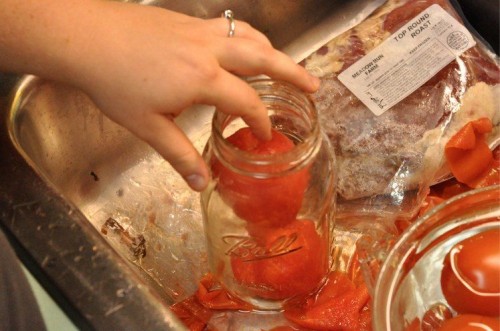
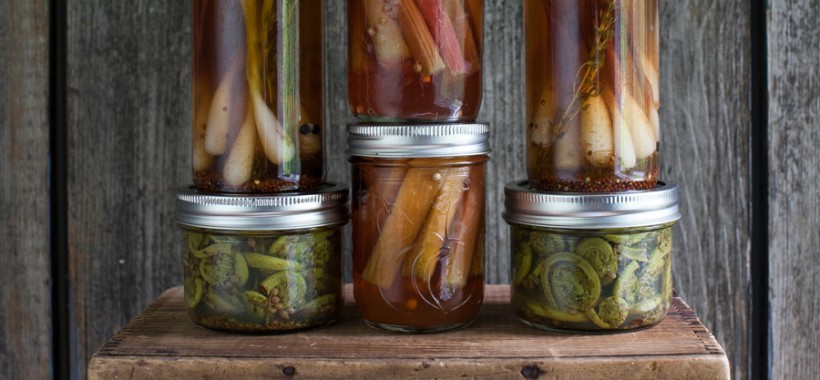
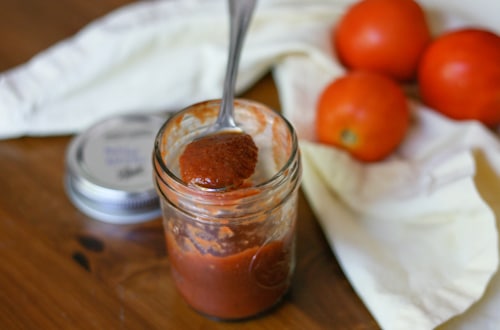
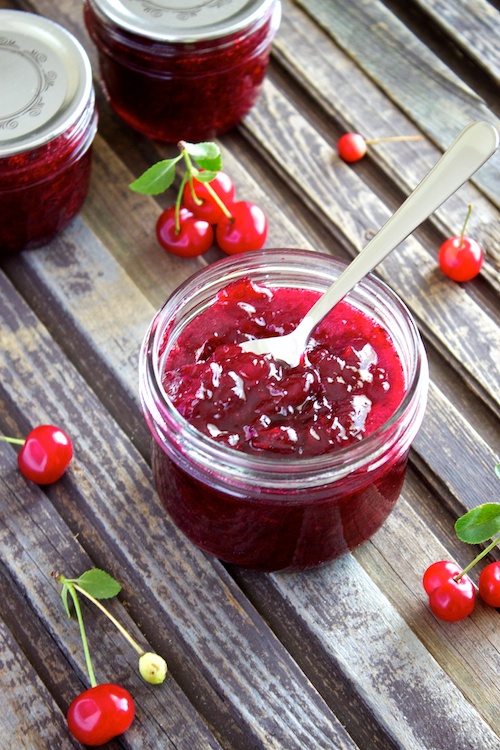
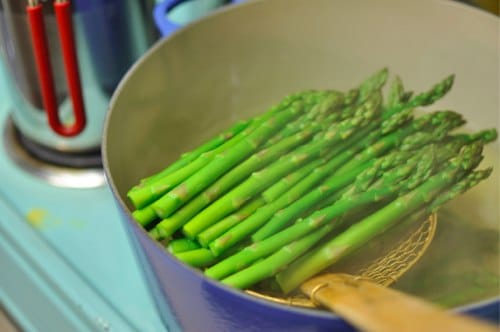
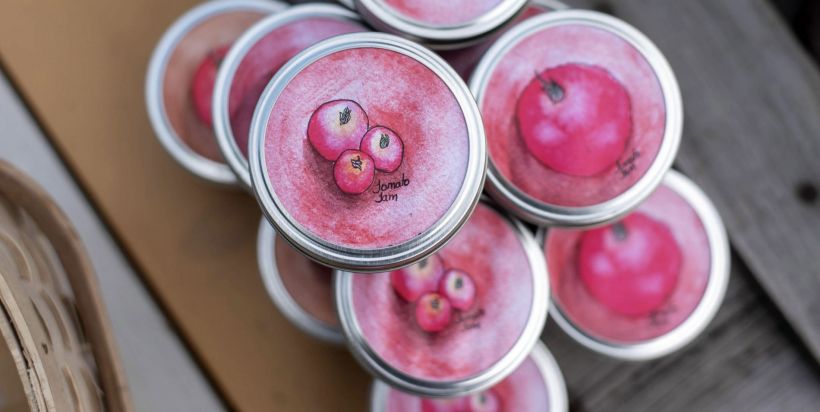
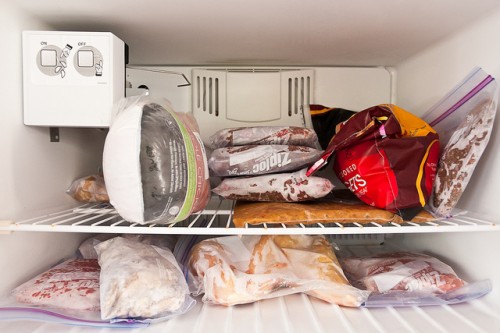
Just wondering how long tomatoes plant can live? I am thinking about transplanting mine back to my greenhouse after the season is over.
Thanks
After my jars cooled they are dusty. Any ideas how/why this happened?
It’s probably just mineral residue from your water. It doesn’t hurt anything, but if it bothers you, just rinse and dry the jars before putting them away.
my neighbor is trying to can SLICED beefsteak tomatoes. She is using a pressure canner. In her first attempt she said she had 2 inches of water at the bottom of the jar which I assume – after reading all of these wonderful submissions – is floating tomatoes. However, she said the tomatoes lost the red color and became brownish. Anyone know what happpened?
Many thanks!
Pam
i canned tomatoes today in a pressure canner when i took them out there about an inch or so of liquid at the bottom of the jars tried not to over pack what did i do wrong and can i still use them need to can some more but dont want to if i an doing something wrong did follow recipe that came with the canner
How long do the last after canning?
Hey Christine,
I think this recipe is designed for water bath canning in a plain ol’ pot, rather than a pressure canner. Pressure canner recipes are different. I think that may have caused your issue.
For example, this site only says to heat for 10 minutes when cooking whole tomatoes in a pressure canner.
*site no longer available*
I’m new to this process..I’ve just canned my freshly purreed tomotoes and after canning them I noticed that at the bottom of the jars there’s a separation a layer of water . I cooked the sauce for a hour and a half like recommended. Did I goof up my sauce?
It’s totally normal. Just shake the tomato puree before using to reintegrate.
Hi there, I’m new to this as well, and I just canned some tomatoes last night following a recipe like the one above, except it didn’t specify bottled lemon juice, so I used fresh. I did everything else according to the instructions, but there are also some small air bubbles, although I did try to get them all out before processing. Does that matter?
I am completely shocked at the presence of raw meat in your canning environment, and especially at posting that to the Internet as if to say it was a safe or good idea. I don’t know, from what I’ve learned about canning over the last decade, it just seems complete common sense to me to want to remove things like raw meat and work in a clean sink, regardless of how long you plan to water bath your product. Why complicate things by having meat bacteria right in the midst of it all? Yikes.
Sometimes life conspires to make it hard to do everything perfectly.
Great Reply! We do not live in a Walgreens world! My mother and grandmother did similar things. Not one person got sick or died. That is three generations of people!
Your grandmother did not have the virulent strains of modern bacteria to mess things up, like E. coli, a thoroughly modern strain. You might also want to consider using a silicone bubble tool for removing the bubbles from your jars–wooden spoons are notorious petri dishes for bacterial strains unknown to your gram.
Nevermind the fact that boiling for 45 minutes will kill off any and all strains of E coli, Salmonella, Campylobacter, etc which may have magically jumped through the wrapping on the meat to the outside of the jar….but please, continue to criticize without doing basic research 😉 Sorry for the snark. Stepping off of my soapbox now.
Hi, I wanted to try your recipe for canning Roma’s but I wanted to can them in juice not water. Would you know how to do that instead?
Thanks so much!
Here are instructions on how to do just that: http://www.uga.edu/nchfp/how/can_03/tomato_juice_pack.html
I have always thought that tomatoes required a pressure canner to ensure all bacteria are killed (something about the pH being tricky, even adding an acid, so they’re a higher risk for botulism)?? I’ve been too afraid to try canning tomatoes because of this. Is it really safe to just water bath them? How long will they stay good/safe to eat?
Lynne, tomatoes do not need to be canned in a pressure canner. As long as you acidify them properly, they are perfectly safe for canning in a boiling water bath. Add one tablespoon bottled lemon juice for pints and two for quarts. They are safe to eat for up to 2 years, though their quality will be better when used within the first year.
I canned tomatoes this fall and used 2 T. lemon juice in each jar. I taste way too much lemon juice. Is there a way to neutralize that lemon flavor? Thank you.
There’s no way to get rid of the lemon flavor. You can minimize it by discarding the water the tomatoes are packed in. In the future, you can use citric acid in place of lemon juice, which should have a less distinct flavor.
Hi, you commented to use the citric acid instead of lemon to Jan Pollard. I used it, and used only what it recommended. It really tastes like lemons, my opinion – although I am fairly new to this process unlike my mother and grandmother God rest their souls, but I would use a little less next time. If I did would it make it likely to not do well without that extra amount added if I left it out?
You cannot safely reduce the amount of citric acid. You need the full 1/2 teaspoon per quart in order to ensure that your tomatoes are preserved in an environment that is inhospitable to botulism growth.
How much citric acid should you use?
You use 1/4 teaspoon for pints and 1/2 teaspoon for quarts.
Just wondering if at different altitude I should prosses longer/shorter? I’m at 4000
Yes. Read this post: https://foodinjars.com/2012/02/canning-101-on-adjusting-for-altitude/
Love your canning instructions! So easy and fast and REALISTIC! I planted 31 tomato plants this year and have Romas coming out my ears! Husband also thought it was a good time to bring home 17 lbs of ripe peaches….Did I also mention that I’m 8 months preggo with number 6?! Ugh. My grandmother also had 6 kids and oodles of grandkids and kept them alive with canned wonderfullness….without todays obsessions over everything. Keep it up! Thanks so much for the tutorials! 🙂
Great minds think alike: I use a salad spinner to collect my tomatoes too!
I like using jersey tomatoes to make my gravy (sauce), they are only in season in july and august. Could I make the gravy like I normally do and then can them for use all year long?
No. You can only can recipes that have been tested and balanced for water bath canning.
Hi,
Thanks for this great post.
I’ve got a question: Sun drying tomatoes is also a very good way of preserving tomatoes but I like them more when they are ‘semi sun dried’ when they still have some moisture inside. Usually that type of tomatoes are preserved in olive oil but would it be also possible to can semi sun dried tomatoes to cut down olive oil? Would the addition of lemon juice be sufficient to preserve them that way?
Just a note–I know many folks will continue to cold-pack and can tomatoes in a hot-water bath, but in 1985, the USDA *did* change the safety requirements and say that hot-packing is preferable (basically, cooking the tomatoes for a while before canning in a hot water bath or a pressure cooker).
Thank you Marisa for your post on canning. I’ve done a number of pickles in the past and jams but never tomatoes. This was an easy-to-follow process and we look forward to enjoying them this winter.
I can with my mother-in-law’s canning instructions and we never used lemon juice…just a tsp of salt per quart. I’ve never had a problem this way. What is the reason for the lemon juice?
Mary Jo, the lemon juice is there to ensure that there’s enough acid in the recipe for safe canning. Modern tomatoes are lower in acidity than they once were and so need to have some lemon juice added to them to be safe. Your MIL’s instructions were probably just fine at one point, but it’s time to update your technique!
I recently cold pack canned tomatoes. I added an onion and some peppers and no lemon juice. I have since been told this is unsafe, that I shouldn’t have added the vegetables unless I was going to pressure cook the tomatoes. Is this true? If so what are my options?
Nola, your technique is quite unsafe for boiling water bath canning. There’s little that you can safely do to save this first batch of tomatoes you made, as they very well could be developing the botulism toxin thanks to low acid levels. In the future, if you want to make a product like this and pressure can it, here’s how you’d do that. http://nchfp.uga.edu/how/can_03/tomato_okra_zucchini.html
When canning tomatoes, can you add garlic and herbs if you use lemon, and use a water bath?
Sue, when it comes to canning tomatoes, the additional lemon juice just makes it safe to can the tomatoes on their own in a boiling water bath canner. You can add a basil leaf or two, but it’s not advisable to add garlic, as it’s a low acid food.
It is unsafe. I recommend discarding these tomatoes.
I’ve been canning tomatoes for probably 15 years. My husband could not survive without them. I have canned as many as 100 quarts in one year. That year they probably lasted 1-1/2 years and I have NEVER added lemon of any kind. I put jars in a 225 deg oven for 20 mins or so while I’m getting everything ready. 1 jar out at a time, add 1 tsp pickling salt, fill with tomatoes. When all tomatoes are jarred, add boiling water, go all around jar with plastic knife removing air spaces, add more water if necessary leaving 1/2″ or so headspace. Lower jars SLOWLY into almost-boiling water in canner, Leave in for 35 mins. Remove and let cool. Taste fresh-picked and both my husband and I are still alive and well – and we don’t have to try to get rid of lemon taste.
If the odd one doesn’t seal, just put it in the fridge and eat it first.
Cathy, your method is not considered safe by current standards. While I can’t stop you from processing as you’ve been doing for the last 15 years, I cannot advise that anyone else adopt your practices.
we canned a bunch of tomatoes the regular way .parboiled/ took off skin/put thejars in hot water, and waited for the ‘pop’, sealed’my question is. we have some jars left over from 2010, the seal is unbroken , are they still safe to eat
thanks very much
bill & patty copeland
Tomatoes are generally thought to be unsafe if you’ve not added lemon juice or put them through a boiling water bath process.
How much lemon Juice and how long is process time
Charles, all that information is listed in the recipe above.
I canned tomatoes for the first time this summer using my grandmother’s instructions. Her process did not include boiling the jars after filling them but instead filling them with the boiling hot tomatoes, putting boiling hot lids on and then placing them upside down until sealed. After reading all the posts I definitely want to boil the cans. Is it too late? My oldest cans are about 10 says d and my newest are from yesterday. Please help! I would really hate to waste all these beautiful canned tomatoes!
I can’t tell you what to do with your tomatoes, but that is not currently considered a safe way to preserve.
How long do these tomatoes last? Should they be discarded after 2 years?
As long as the seals are good, the tomatoes are still fine. I’d use them relatively promptly, but I wouldn’t toss them!
NEW AT THIS CAN I LEAVE THE SKINS ON
It is not unsafe to leave the skins on, but they can turn bitter over time.
I just made 4 pints of salsa but the water would not stay at a constant boil. I have a flat top range so I’m sure it was an issue of not having complete contact between the burner and pan. Is it safe?
If really is necessary to sustain a boil in order to ensure that any present microorganisms are killed.
Marisa
I canned some tomatoes today, but didnt use any lemon or salt. How long do you think they will last ?
Also, there seems to be some small void areas in the jars where air would be, does that matter ?
I had the jars immersed boiling water for 40 minutes.
Tim
It’s natural to have a few air pockets left in jars of tomatoes. There’s no harm in skipping the salt, but tomatoes really do need lemon juice to ensure safety. I can’t recommend them for shelf storage if you did not acidify them in some way.
First time canner. I used citric acid to my stewed and diced tomatoes, but I used old way of canning. I boiled contents in pot, sterilized jars, and added my tomatoes. I put the jars on towel and added rings and lids. All of the jars sealed. I wondered after I saw all the post if I need to trash all or can I just recan and then water bath them.
As long as there aren’t any that are visibly spoiled, you could open the jars, reheat the tomatoes and then process in a boiling water bath canner.
How long should newly canned tomatoes set before you open the jar?
They don’t actually need to set for any time at all. As soon as the jars are cooled and sealed, they are ready to use.
I just canned spag sauce tonight in a hot water bath without lemon juice(I totally forgot that step) can I refrigerate overnight open them in am and recan in lemon juice and hot water bath. Thanks
Yes.
Hello, I’m new to gardening and canning. Once I can the tomatoes, how long can they sit on the shelf before I actually use them?
Unlike pickles, tomatoes don’t need to rest for any specific amount of time. Once the jars are cooled and sealed, they are good to go.
Yes. Just make sure to empty out the jars and bring the sauce to a hard boil before recanning.
Running short on time but have a bunch of tomatoes peeled and ready to go. We are pressure canning and are wondering if we can go ahead and put the ready tomatoes in the jars, refrigerate overnight and process them tomorrow?
Like your site!
That is not advised.
Thank you! Getting ready to can for the first time and chose your directions since they seem the most simplified and clear to understand. Glad I found this post 🙂
Question regarding removing air bubbles with a spatula or wooden spoon, if I forgot to do this what are the consequences? Will it blow up and out when I open them? Can it spoil even though I heard them all pop when I took them out so they did seal okay. Please advise
If the jars sealed, you have nothing to worry about. Removing bubbles simply helps prevent liquid loss during processing and sealing.
I have several canned tomatoes which I put up in 2010. They look O.K. Are they safe to use now?
If they look okay, they’re probably fine.
Hi Marisa!
Thanks for the great instructions. I just had one question: at the end of your post it says “Once the jars are completely cool, remove the rings and test the seal by gently tapping the lid. It should hold tight and be concave” – does this mean you store them without the rings? Or do you put the rings back on to store them once you’ve tested the seal? If you don’t put the rings back on, don’t you have to worry about the lids getting knocked off?
Thanks again!! Jen